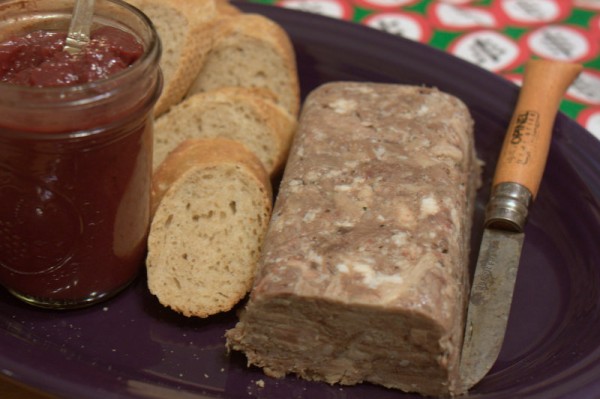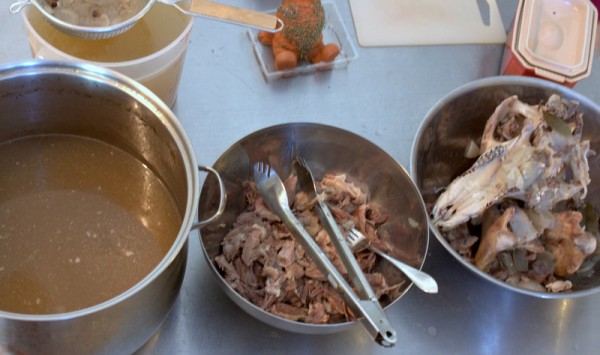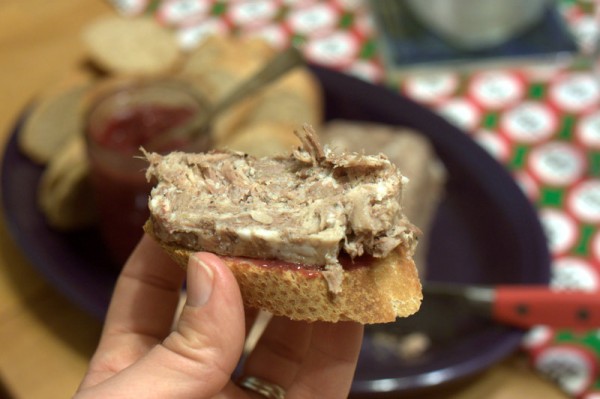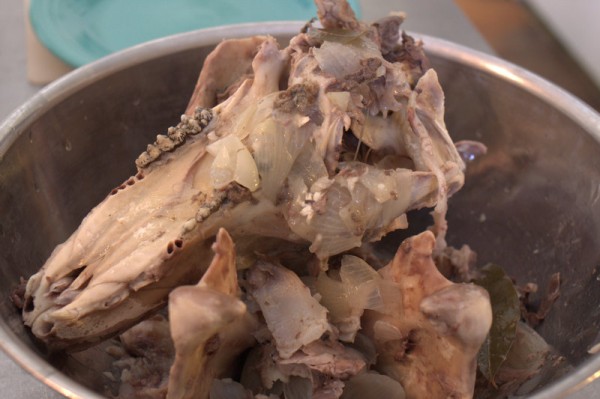 In all our charcuterie practice, there's one part of the pig that we've never fully explored. We finally faced the meat and it returned a couple pounds of tender succulent pulled pieces, 7 quarts of stock, and one specimen for anatomy study. What was it?
In all our charcuterie practice, there's one part of the pig that we've never fully explored. We finally faced the meat and it returned a couple pounds of tender succulent pulled pieces, 7 quarts of stock, and one specimen for anatomy study. What was it?
The head.
When we contracted with a butcher to eviscerate and skin our last pig from Six Bucket's Farm, it arrived head on. "What will we do with that?" we wondered as we dutifully packaged it for the freezer. Our next pig is growing large and almost due to head to the butcher as well, so we're clearing out the freezer. The head demanded our attention.
Making Head Cheese
Alex started the cooking by simmering the head and a ham hock in a large pot of water with onions and garlic overnight in a low stove. (This is the way we make all stock now, by the way.) Next, he picked the meat off the bones, reserving the liquid stock. Lil loved these meat pickings, eating two meals of pork chunks alone.
To make the terrine, Alex combined the meat with spices and a bit of stock. He compressed this mixture in a mold overnight. Find a full recipe in Charcuterie: The Craft of Salting, Smoking, and Curing
"Why does this have to be called head cheese?" I moaned to Alex. It's a seriously delicious potted meat with a name that turns so many people away. The 'cheese' part is a complete misnomer because it's not made of milk or cured with lactofermentation or melty or anything like cheese. Pork terrine is a generic but adequate descriptor. Charcuterie friends also suggested pig parts terrine, souse, or braun.
We're fortunate to have culinarily curious friends who were able to get over the name and try our head cheese. Served on homemade baguette with sour cherry spread, they loved it.
Using Every Last Bit
Later, I reheated the strained stock, sanitized jars, and pressure canned it. Our selection of nourishing stock makes warm meals simple - open a jar, add veggies, meat, noodles, and/or dumplings, and soup is served.
Finally, we needed to dispense of the large skull and jaw bone. The chickens would love cleaning the bones, but instead we delivered them to Alex's mom, a teacher at the School for Young Children, a play-based preschool. She sanitized the bones and added them to the SYC nature table. Lil demands that the next skull can't be given away because she wants it for herself to study.
Meat is Meat is Meat
In processing the pig's head for edible meat, we concluded again that there are no 'good cuts' and 'odd cuts'. It's all just meat.
Some choose not to consume animal flesh, and that's OK. But for those of us who do, what's the difference between eating an animal's thigh versus the cheek? Flesh and fat can be enjoyed from any part of the animal. Bacon, the revered 'makes everything tastier' meat, is from a belly that wallows in mud, if the animal lives a good life.
If you're eating meat at all, you owe it to the creature to use every part. Now we know that the head isn't just an odd cut to be conquered, but one full of succulent meals.
Have you made or eaten head cheese?







